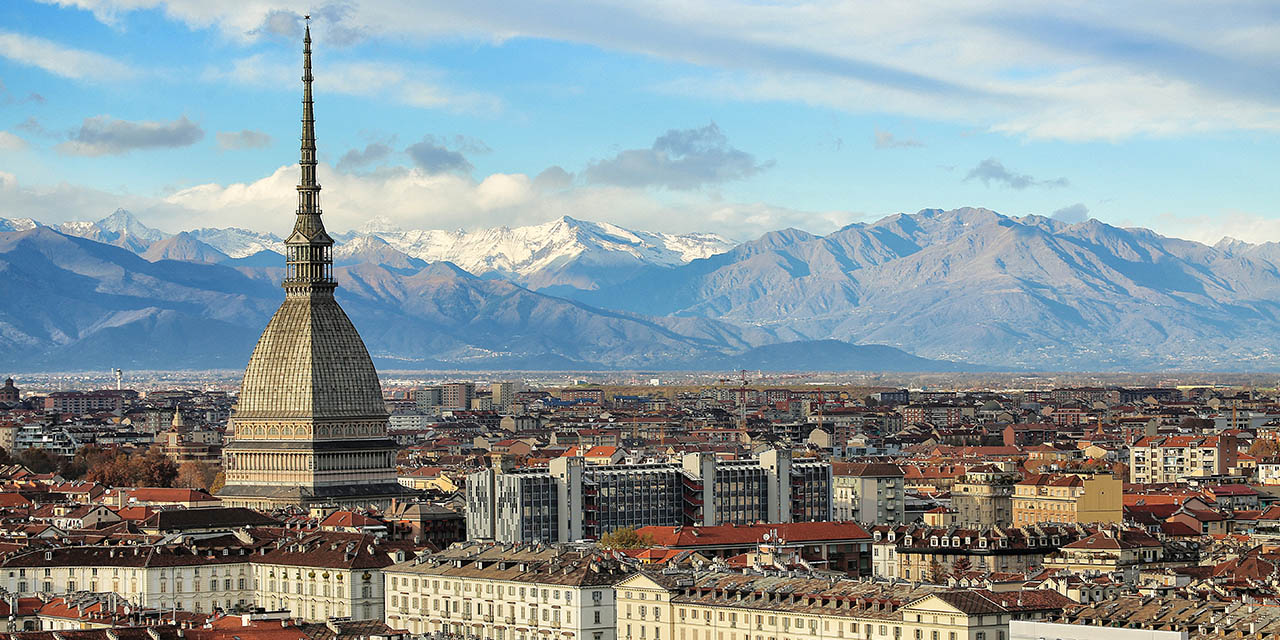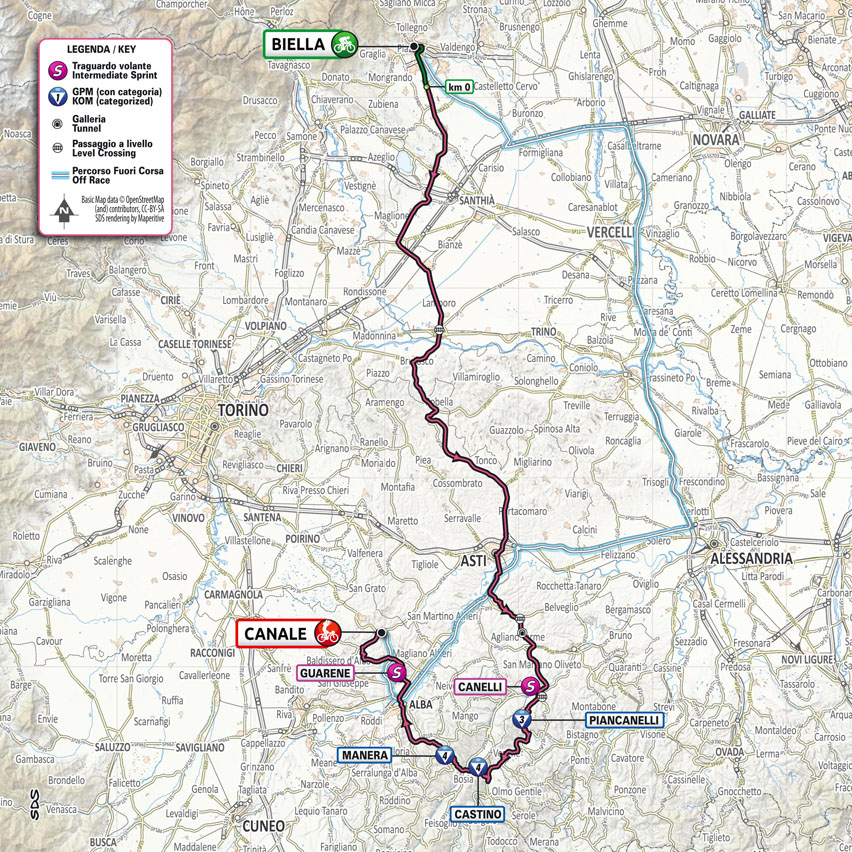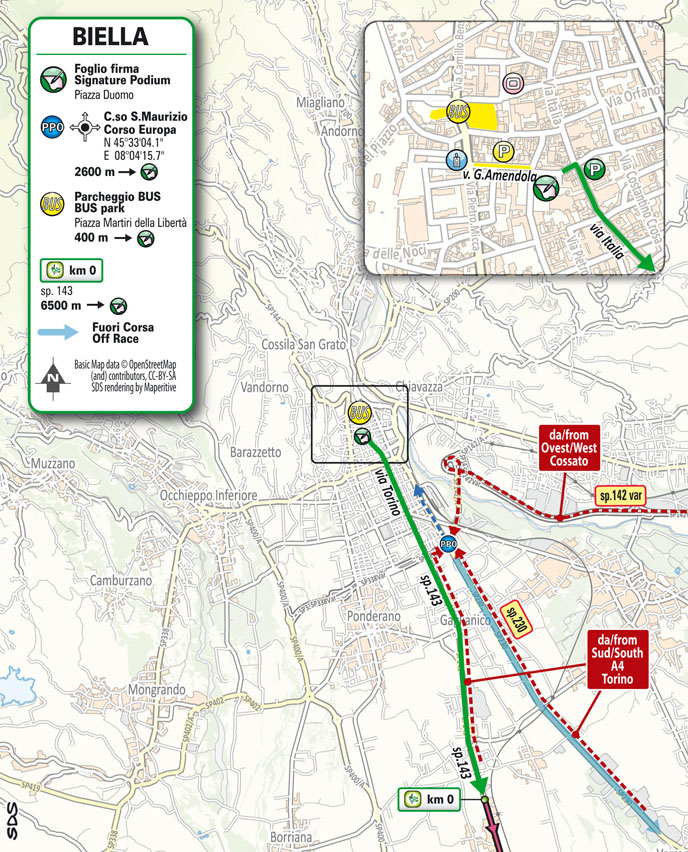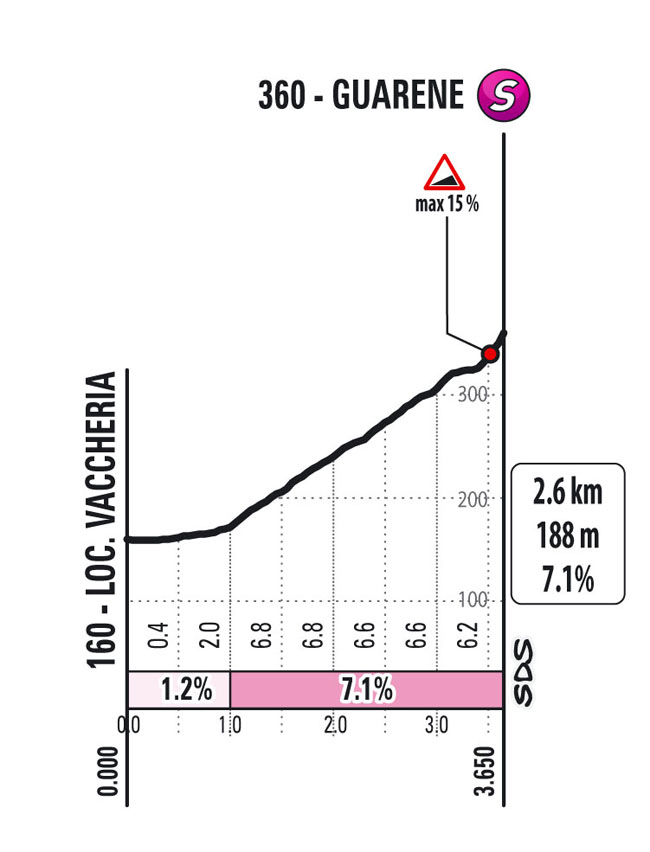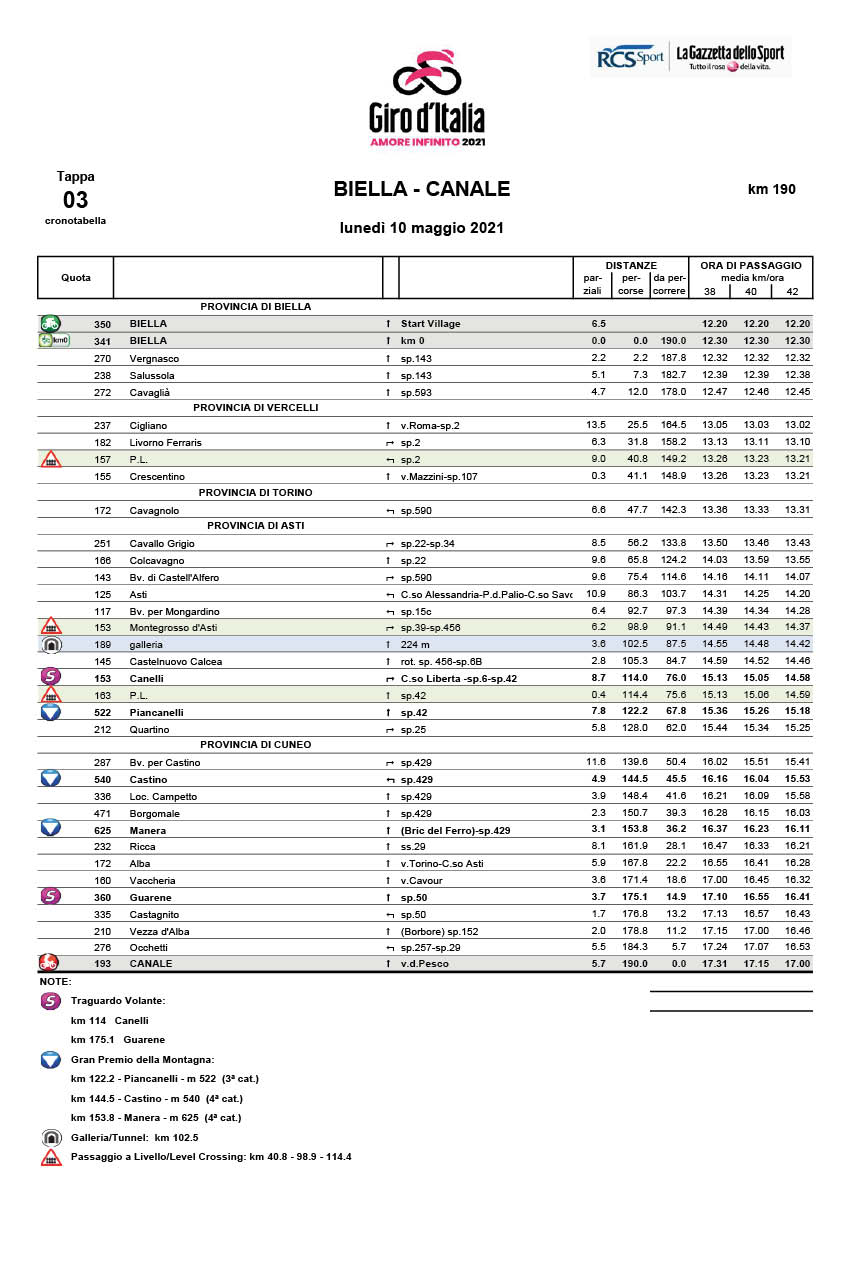profile
map
technical info
This is a half-flat, half-wavy stage. The roads are flat, wide and straight all the way to Asti. Starting in Canelli, the route becomes wavier and takes in three categorised climbs, with sharp gradients at point. Past Alba, there is a steep climb with double-digit gradients in Guarene.
Final kilometres
The stage finale is fairly complex. The route takes in a short, punchy climb up to Occhetti, with 5 km out, and then levels out until Canale. Four wide bends in the final kilometre lead all the way to the home straight, on tarmac road and on a slight incline.
start / finish
climb detail
final kilometres
itinerary timetable
tourist info
Host city:
Biella
Overview
Biella is one of the chief towns of Piedmont and it is situated at the foothills of Biella Alps.
Biella existence is attested since the Early Middle Age, dominated first the bishops of Vercelli and then by the Savoy, during the nineteenth century Biella experienced a great urban and industrial development becoming known for the textile industries.
It develops on several levels reflecting its history: the Piazzo, located on a hill (480m asl) reachable with a panoramic funicular railway, it is the oldest part of the city and retains the characteristics of a medieval village with access gates and cobbled streets that pass through stately buildings.
The newest Biella’s area is dates back to the Roman age and there are important sights from different eras such as the Baptistery and the bell tower, both Romanesque and the Renaissance Church of San Sebastiano, those architectural elements are inserted in an elegant context resulting from the nineteenth-century urban development. Along the Cervo river the monuments of industrial archeology stand out, some of them have now been transformed into cultural centers.
Gastronomy
The local cuisine has a clear Piedmontese imprint, supported by companies nationally and internationally known and by the many small producers who keep the tradition of the territory alive.
Biella’s food and wine is fully counted among the excellences of Piedmont.
Among the best known cheeses we can find the Toma, hard paste, made with cow’s milk, following the ancient Alpine tradition. It is also produced with full-fat milk and it became Maccagno type and with half skimmed milk. The tomes of the Biella valleys have the recognition of the D.O.C. by the Piedmont Region.
These cheeses are also the main ingredients for two great typical dishes: the ‘pulenta cunscia’, a soft cream made with corn, that has to be cooked for a long time in a cauldron, the recipe is a mix of local cheese melted with tasty farm butter and the ‘ris an cagnun’, that is a risotto made with toma and fried butter.
Among the most well known sausages we have: ‘salam d’ula’, that is preserved in fat and made with meet, salt, pepper and sometimes red wine. Others local dishes are “salam d’asu” with donkey meat and those based on goat meat. The production of “salam ‘d patata” is more localized, then the “Paletta of Coggiola”, a shoulder ham flavored with salt and pepper, stuffed into the bladder and dried in the air.
The Biella desserts: the torcetti which are leavened, crumbly biscuits in an oval donut shape. The “paste ‘d melia” biscuits made with corn flour. Canestrelli, fragrant wafer pods with chocolate and hazelnuts.
The great variety of blooms allows to select a wide variety of types of honey: acacia, chestnut, linden, rhododendron, dandelion and wildflower, just to name the most common.
Drinks
The waters of Biella area are famous for their exceptional lightness: one of them is Lauretana with its 14 mg / l of fixed residue which determine its lightness as a European record. Biella also boasts a high quality beer: Menabrea is the oldest active brewery in Italy, and over time it has won several international awards, it has also been judged the best lager beer in the world. Many industry awards also for the numerous micro breweries located in the area that offer a wide selection of craft beers, particular in tastes and with carefully selected and blended ingredients.
Among the wines of the territory, a D.O.C.G .: the Erbaluce di Caluso straw yellow wine, with a fine scent reminiscent of wild flowers and a dry, fresh and characteristic flavor. Red wine is also represented with 4 D.O.C .: Bramaterra, Lessona, Canavese and Coste della Sesia, ruby red wines, with a characteristic and intense aroma, and a dry and harmonious flavor. A special mention goes to the Ratafià di Andorno, a liquor obtained from the alcoholic maceration of wild cherries, according to a 500-year-old recipe.
Main sights
The territory is characterized by a great environmental variety, natural and history.
In the historical town centre is located the Museum of the territory of Biella, this is the museum that collects evidence from the whole area, from Viverone till La Vecchia lake , from Bessa till the Rubello mountain top. The visit to the museum, situated in the cloister inside the St. Sebastiano Basilica, allows everyone to travel in time since prehistoric age to the nineteenth-century. A realistic 3D map of Biella will welcome you at the main entrance hall and the shape of it will give the feeling of being embraced in the map, then the museum suggest two different paths, the first one trough the archeological department (exhibits from paleontology to the Middle Ages) and the other one is dedicated to historic/artistic artifacts (from Renaissance to nineteenth-century collecting).
No tourists can miss the visit to the St. Stefano Cathedral, patron of Biella, built in the oldest core of the town center host a rare example of medieval christian iconographic, disappeared nowdays after the Concilio di Trento : The Sunday Christ. Next to the Cathedral stands another significant example of Romanesque art : The Baptistery, built on a roman burial site.
The city of Biella and the municipality of Pollone host the Burcina natural park, which extends on the slopes of a hill at 826 meters above sea level. Created in the mid-1800s by the textile entrepreneur Felice Piacenza, it covers 57 hectares, preserving numerous specimens of rhododendrons, azaleas and precious conifers and exotic broad-leaved trees perfectly integrated with the existing vegetation. In 1980 it became a Special Nature Reserve.
At few kilometers from the town at 1180 meters above sea level, we can find the Black Madonna Sanctuary, the most famous pilgrimage site in Piedmont, one of the most known in Italy and perhaps the most ancient Marian Sanctuary in the west. The building is considered UNESCO world heritage and the entire area became “Sacro Monte di Oropa Special Nature Reserve”.
A reference point for tourism in Biella’s mountains is Oropa : reachable in a short time from Vercelli, Novara, Milan, Turin and many other cities in the north-west. The cable car, located behind the Oropa Sanctuary, in less than 10 minutes will take you to 1900 meters above sea level, close to Lake Mucrone. In the summer time there is the possibility to go climbing, trekking, downhill or simply enjoy the spectacular landscape of the Po Valley and spend the night over in one of the refuges. During the winter the Camino mountain freeride slopes are the main protagonists, they extend from 2400 to 1200 meters above sea level, there is also the possibility to go hiking with snow shoes and ski mountaineering.
Another natural park near the city is the “Oasi Zegna” protected area in Trivero, 100 square kilometers of naturalistic area with free access in the Biella Alps.
Canale
Overview
Canale has always been a hub between the city of Asti, that founded the town of Canale in 1260, and the green hills of the Roero (it was donated to the lords of this area in 1379), and it is the beating heart of this part of the Piedmont region. A town surrounded by the luxuriant vineyards of Langhe, Roero and Monferrato, with a long history and a lot of interesting local traditions. The history of Canale is well represented by its monuments, such as the bell tower of the church of San Vittore, which stands out over the city with its bronze statue on the top, or as the Malabaila castle, owned by the ancient lords of the area. Canale is a special place thanks to its traditions: its Summer Peach Festival, dedicated to the product that at the beginning of the twentieth century relaunched the agricultural economy of the area; its traditional fruit and vegetable market, open every day (except Saturdays) for over a century, and, of course, its winemaking tradition, which has its solid roots on Roero and Arneis, the gold of these hills.
Speciality food
On these hills, whether they are Langhe, Roero or Monferrato, we cannot talk about gastronomy without mentioning the rarest and most precious product: tuber magnatum pico, the famous white truffle, which in nearby Alba has its “headquarters” with the International Fair that takes place in autumn. If Roero is certainly known for its wines, nevertheless in these limestone soils have been cultivated over the centuries other excellent productions. For example, peaches certainly made the agricultural history of Canale: their cultivations started at the beginning of the twentieth century, when viticulture was put in crisis by the phylloxera and by some terrible hailstorms. Since then, the “peaches of Canale”, with their thick skin, firm pulp and characteristic flavor, became a typical Piedmontese product. Another typical fruit of Canale is the Madonna’s chestnut, also called “Canalina”: particularly appreciated for its early maturation, it is one of the oldest chestnuts in Europe. Another typical product of Canale is roast ham, the result of a centuries-old tradition started by the “Filipin”, some local butchers who found a tasty way to preserve pork legs, roasting and spicing them. It is prepared with a mixture of aromatic herbs and Arneis wine before being cooked in a wood oven. The result is a ham with an intense pink color, soft and tasty. Talking about more recent traditions, a typical dessert of Canale is La Douchesse. It is a chocolate pastry with hazelnuts, almonds and liqueur. The secret recipe has been kept since the early twentieth century by the Sacchero pastry shop (via Roma 39), where it was invented and where it is still produced in an artisanal way. Today many restaurants in the area keep alive these traditions. One of them is the Michelin starred restaurant owned in Canale by chef Davide Palluda, who is a point of reference for the Roero culinary tradition.
Drinks
“It is a very fertile place and the main product of the country are the excellent wines that are made there”: that’s how an ancient text describes Roero, testifying the long winemaking history of these lands. An ancient tradition, which in recent decades has become even more important in the local economy.
With over 370 hectares dedicated to the cultivation of vines (mainly Arneis grape), which make it the most vine-grown town in the area, Canale can be considered the wine capital of Roero. Of these 370 hectares, 240 are those registered with the Denomination of Origin, (175.62 of them are Arneis and 63.10 are Nebbiolo, the two native grapes), and constitute more than 23% of the entire DOCG.
The Roero Denomination has strict rules, that have to be respected to give the grapes and the resulting wines some specific characteristics: for example they must be located on hilly, clayey and calcareous soils.
The most important wines are Roero, a red wine made from Nebbiolo grapes for a minimum of 95%, and Roero Arneis, a white wine made from Arneis grapes, for a minimum of 95%.
In both cases, it should be emphasized how much wine producers work to preserve the product, producing in almost all cases a Roero Docg from Nebbiolo in purity and a Roero Arneis Docg from Arneis in purity.
Furthermore, there is also a sparkling wine made with Arneis, and Roero can be aged for at least 32 months to obtain Roero Riserva DOCG.
Main sights
The arcades of via Roma
The heart of the historic center of Canale are probably its arcades, which drive tourists and citizens through the town, sheltering them from the rain. Under the arcades there are some of the most historic shops in the town.
Enoteca Regionale del Roero
The food and wine point of reference in Canale, Enoteca Regionale del Roero promotes the best local products and the culture of the artisans that carry on the ancient local traditions. The Enoteca is located in the former “Regina Margherita” Kindergarten, an old building restored a few years ago, where there is also Davide Palluda’s Michelin starred restaurant.
Church of San Vittore
Its bell tower, 65 meters high with the bronze statue of the Sacred Heart on the top, is the symbol of the town. The church, with its characteristic peach color (which recalls the delicious and typical fruit of Canale) has a Baroque facade built in 1726.
Church of San Bernardino
In this church of the sixteenth century, rebuilt in Baroque style starting from 1727, there’s a particular artistic work, to which the legend links the destiny of the town. It is a wooden Cross of the fifteenth century, in which Christ has real hair: the myth says that they grow miraculously when a period of misfortune is coming.
Malabaila Castle
Today used as a location for weddings and private ceremonies, the Malabaila castle was the home of the lords of these areas. Built in 1270, it is surrounded by an ancient park with beautiful old trees.
Mombirone Sanctuary
On the top of a hill, on a panoramic point, there is this sanctuary of the sixteenth century dedicated to the Madonna, built near a miraculous water source. It can be reached in about a kilometer of pleasant walk through the Mombirone park, and offers a beautiful view of the historic center of the town and the surrounding hills.











